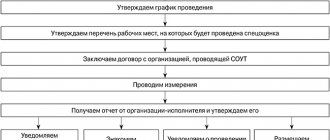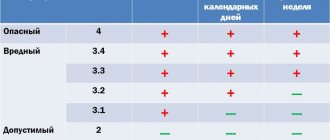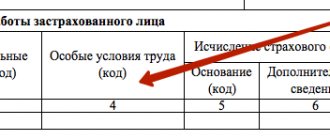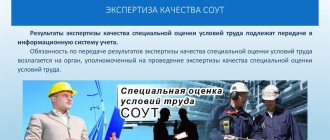Working conditions are an important point when applying for a job. Naturally, many people like it when the conditions are as comfortable as possible, for example, working in an office, which is often called shuffling papers.
However, no one excludes such options that are called harmful and dangerous. And work in these areas is very important, since most often it is connected with life support facilities or with the country’s income. At the same time, people must clearly understand what conditions they are signing up for and what is meant by harmful and dangerous working conditions.
What it is
A degree or class is a set of factors that determine the environment of the workplace.
Not all are equally safe for personnel. In some of them, the performance of duties may lead to the development of occupational diseases, disability and even death. The inspection determines the level of conditions in which people work.
It is important to comply with all regulations and ensure that the indicators are optimal or acceptable, but this does not always happen. Quite often, the specific nature of the organization’s activities is such that people have to perform their duties in a harmful or even dangerous environment. In the first case, it is necessary to compensate the employee for harm, and in the second, the workplace must be closed so that it becomes acceptable.
Occupational safety classification is carried out by a special commission. For this purpose, independent experts are involved. It will not be possible to obtain a conclusion once; you will have to regularly conduct new studies to confirm safety. It's also a good way to reduce harmfulness.
All this is necessary to:
- ensure a hygienic environment and safety for workers;
- if this cannot be achieved, then provide benefits, compensation and treatment to maintain normal levels of health and ability to work.
This question is usually raised at the time of employment. The specialist is given the opportunity to sign not only an employment contract, but also local regulations that describe in detail all the nuances and methods of restoring people’s condition. Every person has the right to be aware of all possible risks before they start their first day of work.
Existing levels
Since the adoption of the Labor Code and at the present time, 4 categories have been distinguished. The document describes the division of professions according to the complexity or danger of existing production factors. Depending on the adopted gradation, additional payments, privileges and benefits for employees of the enterprise are also described.
These requirements and rules are prescribed in the Federal Law of the Russian Federation No. 42, on the basis of which it is possible to distinguish 4 levels of harmfulness:
- the first is characterized by optimal, in other words, normal indicators;
- the second is the permissible nature of the work;
- the third indicates the presence of harmful, severe or complex factors;
- the last, that is, the fourth, describes working conditions in which the likelihood of harm to health is high.
To determine current data, the employer carries out the SOUT procedure once every 5 years. Its implementation is mandatory for all organizations, regardless of the number of employees, but assessment for employees working remotely is completely excluded.
How to determine the class and subclass of working conditions in the workplace
Each employer must follow several steps to document or change parameters. It is recommended to invite a specialized company that has a laboratory and specialists of the appropriate level. Only licensed firms have the right to conduct assessments.
What you need to organize this:
- Convene a commission of your own employees. It usually includes managers, doctors and personnel officers, representatives from the trade union, if there are any.
- Prepare a schedule for how this will happen. If there is no standard agreement yet, you can draw it up in any form.
- Identify similar jobs. This is worth doing to reduce the volume of upcoming events and their duration, and therefore the cost will also decrease.
- An agreement is concluded with a specialized organization for the implementation of SOUT.
- Receive reports and familiarize staff with its results. Tell everyone about what will change and how it will affect their body.
- Carry out actions, correct shortcomings, eliminate dangerous moments. It is necessary to check that all positions comply with the rules.
It is worth noting that any company that will conduct an inspection must meet several requirements:
- carry out activities according to SOUT and undergo accreditation;
- have at least 5 hiring specialists;
- maintain the laboratory in working order;
- prepare and issue reports on the results of such inspections.
As shown in the rental agreement
The inclusion of information that the 2nd class of hazardous working conditions has been assigned and the presence of dangerous and severe criteria is mandatory. The data is placed in a special section, where additional information about the SOUT is published. If the position belongs to the second level, then it is necessary to prescribe actions to comply with requirements and standards.
How many classes are used to evaluate working conditions?
There are 4 varieties in total:
- optimal - rare, since this is an almost ideal environment for people;
- acceptable - all indicators are within the normal range, health does not deteriorate even with a long experience;
- harmful - if you work in these positions for a long time, then occupational diseases and disabilities appear;
- dangerous - in such circumstances, activity is prohibited, conditions must be corrected or work must be stopped.
Each has its own explanations and parameters according to which one or another degree can be assigned. Let's look at this in a table.
| Level | Characteristic |
| Optimal | |
| First |
|
| Acceptable | |
| Second | Exposure does not exceed reasonable limits, but reduces performance, which can be restored during rest:
|
| Harmful | |
| Third | Standards are regularly exceeded, so compensation methods are used |
| Dangerous | |
| Fourth |
|
Optimal working conditions class 1: what does it mean and why is it established?
There are no adverse factors at all or they do not harm people at all. There are opportunities to regularly improve staff performance and productivity.
Valid parameters
The next level in which the impact does not exceed existing standards, and all possible deviations are minimized during rest. Most offices and light manufacturing plants fall into this category.
There are also limits. They are written for each plant and office and are based on the characteristics of the human body, on what is comfortable to do and what is difficult. They are calculated based on the volume of production factors and their impact on the body.
Compliance with such restrictions not only allows the company to remain safe and not pay for harm. These are organizations in which the likelihood of getting an acute or chronic occupational disease is minimal. People risk nothing and can work for decades.
It is worth noting that even seemingly easy tasks are in fact difficult, especially when repeated constantly over several hours, and then years. For example, finding a defective part among dozens of identical ones on a conveyor belt is a matter of two minutes. And identifying the next broken model during an 8-hour shift, where an employee is constantly looking at the tape and identifying unusual parts, is extremely difficult.
That is why it is important to invite independent experts who will check the true state of affairs and draw a conclusion about the real situation.
What class of working conditions includes subclasses and into what parts are they classified?
Here, the characteristics of harmfulness go beyond those in which a person is comfortable acting without harming his condition. Moreover, between shifts he does not have time to rest and recover; if he works for a long time, more than 10 years, he may develop a chronic disease or deteriorate his health.
According to the law, there are 4 subgroups:
- It takes a longer period for the condition to improve. Therefore, to ensure that the specialist does not lose his ability to work, he is entitled to an increased vacation period.
- Production is much more harmful than ordinary offices and factories; factors can cause noticeable functional changes in the body. Because of this, occupational diseases of mild and moderate severity begin to develop.
- Really negative consequences when working in such a company for years. Gradually, serious disorders, occupational diseases and sometimes loss of ability to work begin. You can't work here for decades without major damage.
- Heavy industry and other enterprises in which, after several years, a person may become disabled or may not be able to work at all. Severe forms of occupational diseases appear.
How a dangerous class of working conditions is determined based on the results of the commission
These are the most unfavorable factors. Their exposure to a person for several hours or one shift can lead to serious illnesses, there is a risk of becoming disabled in a short time or dying. It is impossible to compensate for the damage to your condition and well-being. People cannot be allowed to be in such circumstances.
Most often, this degree occurs as a consequence of an accident or emergency. But in some cases, this is the result of poorly thought out processes and activities, the lack of qualified specialists in preparing the plan and mechanisms. Regardless of the reasons, such negative impacts must be eliminated as soon as possible.
What parameters apply
During the work of the commission, attention is paid to several factors of the production environment affecting the employee of the enterprise.
ATTENTION! The parameters by which working conditions are classified are determined by GOST 12.0.002.-80.
Various factors affecting the human body are selected.
Physical factors include:
- The amount of dust in the air at the workplace.
- Noise level.
- Vibration level.
- Temperature.
- Humidity.
- Lighting.
- Electromagnetic radiation.
- Air speed.
Biological factors influencing working conditions - what does this mean?
- These include the presence of microorganisms.
- Presence of disputes.
- The presence of an infection in the workplace that causes dangerous diseases.
Chemical factors:
- This means working with alkali.
- Working with acids.
- Working with paints and varnishes.
- Presence of hazardous chemicals in the air.
When determining the working conditions by which they are assigned to certain classes, a special assessment takes into account such parameters as the intensity of work and the optimal dynamic loads on a person when performing it.
- When studying dynamic loads, the following nuances are studied:
- How much weight does the worker need to lift?
- How actively and often does he need to move.
- Do I need to bend over while working, how often, do I need to turn around.
- Another important point is what position the body maintains when performing production tasks.
Regarding labor intensity, working conditions are characterized by the following parameters:
- What emotional and mental stress does an employee experience during the working day?
- How similar are his movements throughout the day?
If the acceptable level of safety is violated, the worker is exposed to certain harmful factors. His physical and moral well-being and health deteriorate, and his performance decreases.
ATTENTION! Constantly remaining dangerous working conditions lead to occupational diseases, which, unfortunately, is quite common.
Classification of guarantees and compensation for workers under harmful and dangerous working conditions
Based on the results of inspections, damage is determined and specific measures are prescribed.
What can you offer your staff:
- Working hours are shorter than usual. If production does not meet normal standards, you can make a 36 or 30 hour week.
- Additional paid leave. Minimum 7 days above standard. In some cases, it is possible to replace it with monetary compensation.
- Increased pay. If the parameters are not normal, you need to add from 4% to 24% to the flashing part. At least 4%, anything higher is at the discretion of the employer. Additional payment is made exclusively for time worked.
- Early assignment of pension. There is a list of positions where it is recommended to work fewer years in order to retire.
To automate production activities, we recommend installing special software from Cleverence, which will make it much easier not only to control the work process, but also to optimize routine tasks.
Do you want to implement Warehouse 15? Get all the necessary information from a specialist.
Thank you!
Thank you, your application has been accepted!
Hygienic criteria and microclimate indicators
Hygienic criteria are indicators that allow us to assess the extent to which the parameters of production activities and the labor process are violated in relation to sanitary and hygienic standards established by law.
The indicators by which the microclimate is assessed are as follows:
- ambient temperature;
- air humidity;
- wind (speed);
- heat (intensity).
Indicators are divided into:
- Optimal - maintain the normal thermal state of the worker, without straining the mechanisms of regulation of human body temperature.
- Acceptable - cause temporary changes in the thermal state of the worker, cause temporary tension in the mechanisms of regulation of human body temperature, discomfort in the sensation of heat, and a decrease in the level of ability to work.
What classes of working conditions are there and why are they declining?
The audit is performed more than once for the entire period of the organization’s activities. It is regularly carried out again, identifying new circumstances, if any. In addition, each position is required to have a job description and survey to determine the level of hazard.
If all company employees use personal protective equipment and fully comply with all regulations, the harmfulness may officially become lower. But also only after a fresh examination of the SOUT.
As stated by the hazard class
Take a comprehensive approach to assessing workers' conditions. Analyze the negative impact of causes on the health of workers.
During the special assessment, the proportionality of the sanitary and hygienic characteristics to the standards is determined:
- the presence of harmful impurities in the airspace of production sites;
- microclimate;
- noise, ultra-infrasound;
- magnetic and ionic radiation;
- degree of lighting of production sites.
According to the data obtained, a hazard class is assigned.
Harmful—causing decreased ability to work, occupational diseases. The following are considered harmful:
- physical: temperature, air humidity, magnetic field, low light;
- chemical factors: presence of dust and gases;
- biological: microorganisms that cause diseases;
- workload factors: physical load; Exceeding the worker’s stereotypical movements, increasing body tilt;
- labor intensity: monotony of the work process, emotional stress, intellectual.
Dangerous causes are those that cause a sharp deterioration in health, injury, or death. These are electric current, moving parts of machines, fire, sharp edges of equipment, a heated surface, and the like.
Create a report
Upon completion of the special assessment, a final document is generated containing the results of the tests performed. The Law of December 28, 2013 No. 426-FZ established the contents of the report. He contains:
- information about the company that carried out the special assessment procedure;
- data on employment positions;
- information on the results of measurements, examinations, information on the effectiveness of personal protective equipment for workers;
- recommendations on improving the quality of working conditions and improving labor protection;
- final conclusions of the appraisal company;
- information about the approval and signature of commission members.
The inspected places of workers are described in the report.
What are hazardous working conditions?
There are such degrees of harmfulness of work:
- first degree of harm.
Unfavorable factors in the work environment can cause a number of negative health changes that disappear if the employee breaks off contact with them for a long time;
Significant changes occur in the functioning of an employee’s body due to the influence of various factors during work. They concern mainly those organs that suffer most from this type of activity. The employee may temporarily lose his ability to work. It is restored some time after the cessation of work;
An employee suffers from an occupational illness. Their severity can be mild or moderate. The employee loses professional ability to work while performing his work;
Working in such conditions can lead to the occurrence of serious illnesses. They can be chronic. The employee loses the ability to work in any field.
Harmful factors affecting employee health:
- physical factors;
- chemical factors;
- biological factors;
- labor factors.
For example, if the temperature at work is very low, the employee may experience acute respiratory diseases. And if an employee has to work at night, or the working day exceeds acceptable standards, difficulties may arise with concentration and well-being in general.
With prolonged adherence to this work regime, sleep disturbance occurs. The degree of influence of these factors on the life and health of an employee will directly depend on the strength of their influence.
The procedure for determining the class and categories for working conditions in the workplace
Once every certain period of time, an assessment of the situation at the enterprise is carried out.
There are several goals here:
- identify unfavorable factors;
- establish to what extent they affect the body;
- identify the size of the deviation of the real value from the standards;
- evaluate the effectiveness of measures to restore the health and well-being of personnel.
It is worth noting that psychophysical characteristics are also those that should be compensated by increased rest, salary or other preventive measures.
All assessments performed by inspectors are subject to mandatory publication on the organization’s website, if there is one, and also to the attention of all employees. The company administration has 30 days for this process. This data is also sent to a special state information system. Only information that relates to state secrets or other information protected by law should not be transmitted.
Labor process
For this point, experts identify the following criteria:
- the severity factor of working conditions of class 2 is physical activity;
- tension in terms of overload of the nervous system and sensory organs.
In this case, all indicators are taken into account: those that increase or decrease the level. So, for example, the need to carry cargo, the distance to the destination, weight, number of transported items, and time costs are determined.
Work is considered stressful if workers need to constantly maintain concentration, perform monotonous actions, communicate a lot, or manage transport, which is most typical for a dispatcher, driver, or assembly line worker.
What negative factors are assessed
To determine which assessment classes exist at the enterprise and which of them correspond to normal working conditions, specialists carefully analyze all the nuances. It is necessary to find and record what exactly and how much it affects the human body during one shift.
There are usually three groups:
- physical - noise, vibration, light, ultrasound and the like;
- chemical - personnel receive negative effects from compounds and substances;
- biological - the consequences of the spread of microorganisms, bites, spores and fungi.
But this also includes psychophysical ones, when a person is overexerted from overly concentrated or monotonous work.
To make it easier to determine into which classes working conditions are divided, inspectors usually draw up a table where they enter all the likely impacts on a person. Then they determine how much each of the features affects people.
The more serious the harm, the greater the funding for compensation. Every detected nuance is necessarily documented and steps are taken to correct it.
If the experts decide that it is safe to work, then no compensatory actions will be taken.
Important - remote specialists and homeworkers are not studied, as are those hired by individuals without special status.
Do you want to implement “Store 15”? Get all the necessary information from a specialist.
Thank you!
Thank you, your application has been accepted.
Normative base
According to Article 212 of the Labor Code of the Russian Federation, ensuring harmless conditions is entrusted to the company where they work.
Firms carry out assessment activities according to the imperative of December 28, 2013 No. 426-F Z. Let's consider which workplaces are subject to a special assessment of working conditions. The concept of working conditions in the system of ensuring the safety of life and health of workers in the process of work is established by Art. 209 Labor Code of the Russian Federation. The employer's obligations to ensure safety and working conditions in accordance with state regulations are regulated by Part 2 of Art. 22 and Art. 212 Labor Code of the Russian Federation.
All regulatory and legal aspects relating to the conduct of SOUT are set out in Law No. 426-FZ. To assign a class of working conditions, measurements and expert assessment of factors of the place of work, the working environment and the labor process are carried out. Based on Art. 13 of Law No. 426-FZ, the assessment is made taking into account the following categories:
- physical factors
- chemical factors,
- biological factors,
- severity and intensity of the labor process,
- intensity of the labor process (static and dynamic loads),
- environmental indicators,
- characteristics of various radiations and fields,
- sound and vibration parameters,
- degree of illumination,
- concentration of harmful substances in the air.
All indicators correspond to the standards established by SanPin and specified in Guideline R 2.2.2006-05. For each of the exposure factors, acceptable standards have been established that are considered safe for the health of workers. The evaluation criteria are based on the degree to which actual working conditions differ from acceptable hygienic standards.
Details about harmful factors, working conditions and employer responsibility
Measures according to workplace hazard classes
The main actions that should be performed are enshrined in law. They are designed to protect personnel and give them property and financial benefits commensurate with the losses of people.
For example, it is important that an enterprise assigns a shortened working week to everyone with a hazard class higher than 3.2. Mandatory additional leave is prescribed for everyone with a level of at least 3.1. Salaries increase for everyone with degrees 3 and 4.
Additionally, they can give out milk and other therapeutic and prophylactic products, and send them to sanatoriums so that they can improve their health. What exactly to use for a specific position depends on the profession.
For those who work in heavy industries, it is possible to retire immediately after working a certain number of years.
Each company will have to pay increased pension contributions and contributions to social funds for its employees. For example, if the harmfulness is 3.4, an additional tariff of 7% is transferred.
The employer is obliged to indicate the class and, if necessary, subclass of working conditions in the Republic of Moldova in the contract. In addition, he must tell what the specialist’s activities will consist of and how harmful it will be. By signing this document, a person confirms that he agrees to all the circumstances in their entirety.
If any of the events that happened changes, it is necessary to change the composition of the employment contracts of all persons who work in close proximity to the facilities. But this is allowed to be done only after collecting the next SOUT commission. If the inspectors noted that everything remains the same, then no changes need to be made.
Medical examination for second level personnel
In the case of the 2nd degree of danger, medical examinations are not an obligation for both parties to the employment contract. The rule is described at the all-Russian government level and confirmed by the recommendations of Rospotrebnadzor. At the same time, medical examinations are recommended for representatives of categories 3 and 4, as well as for workers in the motor transport environment. Such features make it possible to timely identify access to performing assigned tasks and prevent the development of occupational diseases.









